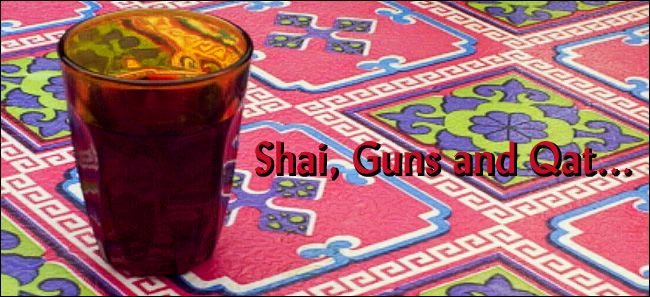 ViewZone's Gary Vey in Yemen
Venturing to the North of Yemen was a rich experience. The Yemen government insists on safeguarding foreign tourists by assigning an armed convoy for the journey to Marib. Vehicles meet at a checkpoint just outside Sana'a and travel in a row towards Marib. As the trip gets underway there are frequent stops for a glass of hot tea and then for a relaxed lunch in one of the roadside restaurants. It is customary to buy the meals and tea for the half dozen soldiers assigned to the detail and they are often also given cigarettes and qat. The average age for a soldier is 20 years old and the preferred weapon is an AK-47. Soldiers insist the M-16 jams in the sandy and dusty climate. |
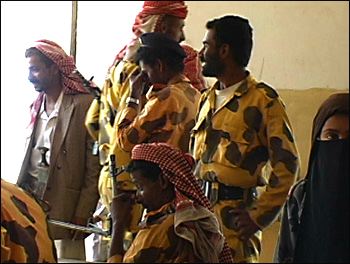 In the North there are many guns. In fact, Yemen has one of the highest ratios of guns to people in the world. Teens often brag that they are excellent marksmen and offer to demonstrate their skill by lighting a cigarette in the mouth of their peer from a hundred meters. We never asked to verify this claim but I am confident they could do this.
In the North there are many guns. In fact, Yemen has one of the highest ratios of guns to people in the world. Teens often brag that they are excellent marksmen and offer to demonstrate their skill by lighting a cigarette in the mouth of their peer from a hundred meters. We never asked to verify this claim but I am confident they could do this.Guns are carried in Marib the way that English gentlemen would carry a walking stick. A man is simply incomplete without his weapon. And yet, for all the brandishing of arms there is very little violence. In the entire stay in Yemen we heard shots fired only at weddings and always in the air. The ability to respect fire arms and the absence of violence is a mystery to westerners, who believe that guns are the main cause of violence. In a word: relax. Yemeni men are more experienced with firearms than most Navy Seals. Safety latches are always on and no inappropriate use of weapons is tolerated. If you have an understanding that this is a cultural element associated with the northern tribes of Yemen then the rifles will be no more than a colorful embellishment to the otherwise breathtaking scenery. If being around guns bothers you then limit your visits to the East and South Yemen.
|
|
To Qat or not to Qat
Every day at about noon, our guides and driver stopped for lunch. At the end of the meal, as I was finishing my shai, they would disappear and return about an hour later. After a few days I followed them and located the various hidden qat suqs (markets) in the back alleys of the tin sheds and cement block buildings. They would look at the bundles of qat leaves and quibble about the price before buying their daily supply. There was apparently a variation in the taste and freshness of the leaves that was revealed by their color and flexibility. Shaking the qat was part of the appraisal.
I was told that I would not truly understand Yemeni life and culture unless I partook of the local narcotic, qat. |
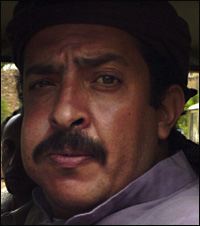
|
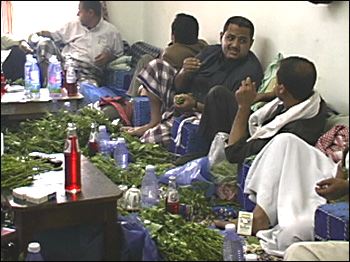
Qat is an inconspicuous tree with oval green leaves. It grows to about 8 feet and is harvested regularly by picking the new green leaves that form on the end of the branches. The young leaves are preferred because they can easily be chewed into a fine pulp and yield more of the active alkaloids that produce an effect like strong coffee. As the day ends, virtually all of the Yemeni men have accumulated a large wad of qat -- often the size of a golf ball -- stuffed in their right cheek. Even young boys begin chewing at about the same time as they receive their first, scaled-down jambia (curved knife). Chewing the leaves reduces the appetite and hunger while it increases work output and energy. On many occasions I saw workmen in the various suqs chewing large wads of qat while they produced iron tools, wooden cabinets or delicately crafted silver jewelry. If anything, qat seems to increase productivity while providing a common cultural experience that binds the various tribes and villages. To be Yemeni is to chew qat. Previous Page || ViewZone || Next--> |
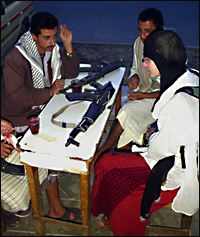 Yemen was once two very different nations. The southern part, along the coast of the Arabian Sea, was controlled by the Communists during the Cold War, because of its strategic importance. The northern part which borders Saudi Arabia was never occupied and remained under the rule of the Imam until the country was united as a republic some 40 years ago. This resistance to Communist control was made possible by the tradition of the northern tribes to be well armed and proficient. Children as young as 12 and men as old as 60 can muster into a defensive army on a few days notice.
Yemen was once two very different nations. The southern part, along the coast of the Arabian Sea, was controlled by the Communists during the Cold War, because of its strategic importance. The northern part which borders Saudi Arabia was never occupied and remained under the rule of the Imam until the country was united as a republic some 40 years ago. This resistance to Communist control was made possible by the tradition of the northern tribes to be well armed and proficient. Children as young as 12 and men as old as 60 can muster into a defensive army on a few days notice.